Which company is better than stainless steel pots?
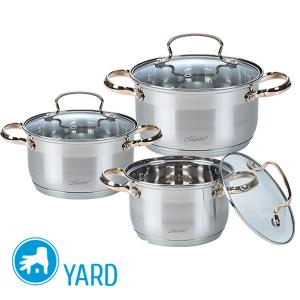
Once every few years, housewives update their kitchen utensils, including pots. At the moment, manufacturers offer such a wide range of these products that it is easy to get confused: which company is better than a stainless steel pan? Or maybe move away from the classics and buy a glass one? Yes, and how to choose this same pan?
Everyone knows that the taste of a cooked dish, its safety for health, cooking time and much more directly depends on what it was cooked in. In order to buy the right dishes, you need to arm yourself with knowledge in this area. Our article will help you in this to the fullest.
to contents ↑How to choose a pan? Criterias of choice
Arriving at the store for a new “kitchen assistant” you need to be guided not only by the beauty of the flowers on the sides of the pan, but also by the characteristics of the material from which it is made. And also pay considerable attention to other important aspects. It is about them that we will discuss later.
Plate type
When buying, first of all, proceed from the stove or hob you have:
- For a gas stove, all types of pots are suitable, except for glass and ceramic.
- For electric - everything except aluminum pots is suitable.
- For glass-ceramic hob - steel, glass and other types of pots, except cast iron. The main thing is that their bottom is perfectly flat and round, with a thickness of at least 3 mm.
- For induction cooker - pans with a thick steel bottom.

Volume
Be sure to consider the amount that you need before deciding which pans are best - enameled or stainless:
- If you cook soups, side dishes and compotes for a large family, then this should be a pan of 3 or more liters.
- For cereals, sauces and vegetables, a smaller container will fit.
- And if you need to boil milk for the baby, then it is enough to purchase a small aluminum bucket.
Scope of use
Decide on the purpose for which you are buying a saucepan in order to understand for yourself which saucepans are better - enameled or stainless steel, or maybe cast-iron or glass:
- For a long stew, a cast iron pan is best.
- For baking in the oven - ceramic.
- If you prefer to cook with a minimum of oil, then your option is a teflon-coated pan.
Important! It is worth noting that it is inappropriate to buy a set of pots. It is better to take several products from different materials.
As you can see, there are tons of options for such dishes. And to make the right choice, you must first thoroughly examine all types of pots, their pros and cons.
to contents ↑Stainless steel pan
Now the market is full of all kinds of stainless steel pots. They attract us with the brilliance of steel, stylish transparent covers. Famous chefs in culinary programs prepare their masterpieces in them, and not in enameled saucepans with poppies on their sides.
Benefits:
- These products do not emit harmful substances in food, therefore they are considered highly ecological.
- In them you can cook and stew anything. You can also fry, but the casseroles handle this function a little worse.
- They are easily washed after cooking and are not afraid of contact with metal cutlery (scoops, spoons).
- Due to the shiny walls, these pans give less heat to the environment and keep food hot longer.
- When used, these pans do not deform and do not react in any way to temperature changes.
- If the pan is made with high quality, then the food in it warms up evenly and does not burn.
- Suitable for all types of plates.
Disadvantages:
- Food cannot be stored in these pans for a long time.
- It is not recommended to clean stainless instruments with abrasive products, otherwise scratches will appear on the surface.
Important! Even if you carefully clean such pans, over time the luster of the steel will still fade.
- Permanent dark spots from strong saline solutions may appear on the walls of stainless steel pots.
- It is worth carefully monitoring the liquid level in the upcoming dish. If the water boils and the pan overheats, then yellow spots will remain, which are very difficult to get rid of.
- It is not recommended to use such pots for cooking in ovens.
- For many, a significant disadvantage of such utensils is their high cost.
How to choose a stainless steel pan?
If you have weighed the pros and cons and decided to buy a stainless steel, then you must know how to choose a pan.
Options and Appearance
Going for a new pan, do not be too lazy to bring along a regular ruler. To understand which company is better than a stainless steel pan, do the following:
- When inspecting the product, measure the walls. They should not be thinner than 0.5 mm.
- The surface should be smooth and radiant.
- Use a ruler to measure the thickness of the bottom. It cannot be less than 3 mm.
Important! The thicker the bottom of the pan, the better.
- Ideally, the bottom of the dishes should be triple: between the layers began to put a layer of aluminum, bronze or copper. This ensures uniform heating. Thus, the food will not burn.
- There may be a seam between the walls and the bottom. Take a close look at the clearance. It should never be.
Marking
Find the steel marking to see which company is better than stainless steel pots. As a rule, it is placed at the bottom of the product or on the packaging. The marking numbers indicate the ratio of chromium and nickel in the metal alloy. Medical steel is considered the best, which is indicated by the numbers 18/10. There may be designations 08/13, 12/13 or 12/18, but they are not the best indicators.
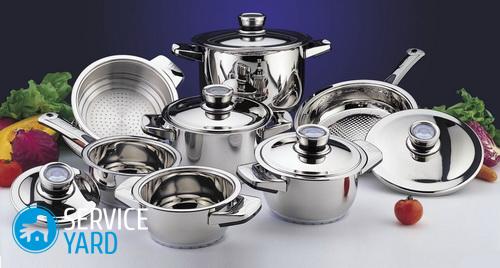
Handles and pan cover:
- It is worth looking at the product pens. They should be firmly bolted to the walls and not stagger.
Important! It is very convenient if the handles are coated with heat-resistant silicone.
- The lid should fit snugly against the sides and have an opening for steam to escape.
The brand
Pay attention to the pan manufacturer. Good manufacturers are:
- Tefal;
- Calve;
- Berghoff;
- Kaiserhoff;
- Rondoll;
- Vinzer;
- Solinger.
Products of these brands are manufactured in Europe.
From domestic praise TM “Katyusha”, TM “Gourmet”.
Important! Try to buy a pot not on the market, as there are often Chinese fakes, on which the marking does not correspond to reality. It is better to buy dishes in a specialized store or on the official website of the manufacturer.
Considering all the recommendations, knowing how to choose a stainless steel pan and which company is better, you can buy a stainless steel assistant for many years.
to contents ↑Enamel Pans
Enameled pots are quite a big competitor to other types of similar products. They have long and firmly settled in our kitchens since Soviet times. And until now enameled pots on store shelves amaze our imagination with a variety of colors and patterns. Of course, it's up to you to decide which pots are better: enameled or stainless steel. But if you prefer a saucepan with cute cornflowers on its sides, then check out the pros and cons of this cookware.
Benefits:
- Spectacular and cute appearance. Enameled pots can be matched to any kitchen interior. They look beautiful when served on the table.
- They can cook any dishes - soups, cereals, side dishes. Enamel is neutral to all types of food, acids, salt, and does not emit harmful substances during cooking.
- They can store food, so these pans can be attributed to environmentally friendly.
- When used, the pots are not deformed.
- Enamel pans are perfectly cleaned with liquid detergents.
- Suitable for all stoves except induction.
- Budget price. Compared to new products made of glass or refractory ceramics, these products are inexpensive.
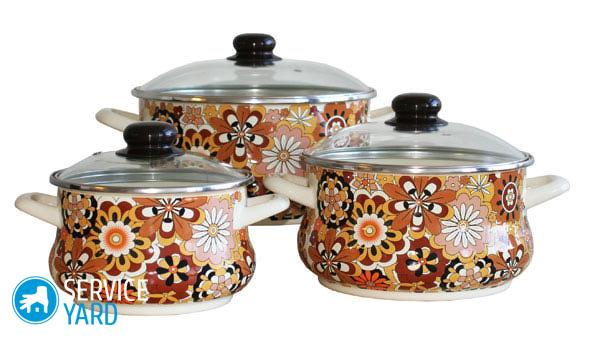
Disadvantages:
- Enameled pans have low thermal conductivity, so the water in them boils slowly.
- They are very sensitive to shock. The enamel breaks off, and if this happens inside the product, it will have to be thrown away, as harmful metal salts will penetrate the food during cooking.
- Enamel in pans is afraid of sudden changes in temperature. As a result of such, it may crack.
- Milk and thick cereals can burn in these pans.
- When cleaning enameled pans, it is undesirable to use abrasives and strong acids, so as not to damage the upper protective layer.
Criteria for choosing an enameled pan?
If you, having familiarized yourself with the strengths and weaknesses of enameled pans, still chose them, you should find out which pans are the best. When choosing enameled dishes, it is important to know some features of its production.
Enamel quality
At the base of the pan there is a metal bowl, which is covered with glassy enamel. High-quality and durable enamel is possible only when applied by immersion (dipping). In this case, barely noticeable 2-3 dark points from the fasteners remain on the outer surface of the pan. If the manufacturer decided to save, then the pan is coated with enamel by spraying. Such an enamel will be uneven and thin, it is very fragile and short-lived.
Important! Carefully consider the quality of the coating in the light. It should be the same everywhere.
Enamel color
The color of the enamel inside the pot also matters. The black inside is considered the best. White, cream, gray-blue and blue enamel colors are also safe. All the rest are toxic.
Damage
If upon careful inspection you find even the smallest crack, scratch or chip inside the pan, discard it and choose another. Food should not come in contact with metal that is under the enamel. Lead, cadmium or other toxic substances can get into it, which, accumulating in the body, will harm the kidneys, liver and bone marrow.
to contents ↑Important! If during operation you damage the enamel - do not regret throwing it away. Health is always more expensive.
Aluminum pots
Although aluminum pans are considered by many to be “the last century”, having one of them on the farm will not hurt. In such dishes, it is best to boil milk, cook milk porridge, it is convenient to quickly boil sausages, dumplings or eggs. It is enough to purchase a small saucepan or ladle for such purposes.
Benefits:
- These pans are light in weight.
- Relatively cheap.
- They quickly boil water, which saves gas consumption, does not burn milk and milk porridge.
- They are unpretentious in leaving. Easy to wash.
Disadvantages:
- Tendency to deformation.
Important! If you purchase a modern model with a thick bottom and walls, then this problem can be avoided.
- It is not recommended to store food in these containers. From long contact with food, aluminum salts can get into it, which adversely affect the kidneys, liver and musculoskeletal system. Harmful compounds can also be released in contact with acidic products. Therefore, it is recommended to cook dairy dishes in them (after cooking, pour them into other dishes) and boil semi-finished products (something that quickly cooks).
- When cleaning the product, do not use abrasives and metal scrapers, otherwise the surface will be scratched.
- Such dishes cannot be used on an electric stove and on an induction stove.
What to look for when buying?
To correctly determine which company is better than a pan from this alloy, consider such conditions.
Bottom and walls:
- When choosing this pan, pay attention that the bottom is flat.
- The bottom thickness should be at least 3 mm.
- Wall thickness - from 1.5 mm.
- The inner surface should be scratch-free, as they violate the integrity of the oxide protective film.
Cap
The lid should fit snugly against the walls of the pan and should not fly off when tilted to 45 degrees.
Pens
Handles should be bolted to the walls of the pan, not welded. Check that they are not staggering.
to contents ↑Cast iron pots
Another “hello” from the past. Today they are quite rare “residents” of our kitchens. On sale, they also almost never meet. But nevertheless, some housewives successfully use cast-iron containers. Therefore, it is worth discussing their advantages and disadvantages.
Advantages:
- Cast iron pots - quite durable and resistant to mechanical damage. When cooking, you can safely use metal appliances.
- The severity of cast iron gives them additional stability.
- The porous surface absorbs fat and oil well, which will prevent the dish from burning.
- In these pans you can cook for as long as you like on gas or in the oven. You can stew or simmer meat, and pilaf and roast will turn out to be especially tasty.
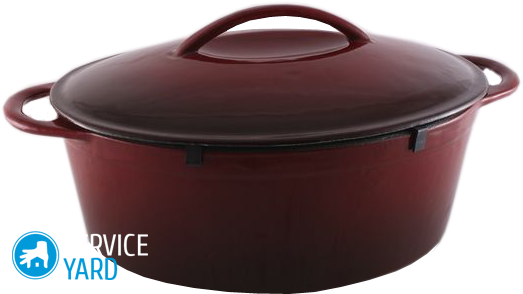
Disadvantages:
- These pans cannot be used on ceramic and induction hob surfaces.
- They heat up for a long time, which increases the cooking time.
- Pots are heavy and afraid of falling from a height. If you drop it, it may crack.
- Cast iron pots cannot be washed in dishwashers. And after washing by hand - it is necessary to wipe it dry so that rust does not appear.
- In such dishes, you can not store food for a long time, it can darken.
Cast Iron Pan Selection Criteria
If you still decide to purchase a pot of cast iron, especially for cooking pilaf for example, then you need to know the selection criteria:
- A pot of 3 liters should weigh 4-4.5 kg, no less. In this case, the bottom and walls should be thick.
- The surface must be porous. It is this property that gives cast iron a “non-stick” effect.
Modern pots
Novelties of the modern market of kitchen utensils are teflon, ceramic, glass products. Why are they convenient and which company is better than pans of this type?
Teflon pans
These are the best pots and the most sought after for those who are trying to cook healthy or dietary foods using a minimal amount of oil.
Benefits:
- When cooking, Teflon does not react with food and does not absorb odors.
- The food, when heated, does not stick to the surface and does not burn, even if cooked without oil.
- They warm up quickly, which reduces the cooking time.
- Suitable for all stoves except induction.
Disadvantages:
- Short service life. Even with careful handling, over time, the Teflon coating becomes thinner and damaged. As a result, toxic carcinogens can enter the food.
- To avoid damaging the coating, use only silicone or wooden spatulas.
- Do not clean with hard washcloths or abrasives.
- If thin aluminum serves as the base under Teflon, then the container may become deformed from overheating (the bottom bend, for example).
Important! When choosing such a dish, pay attention to the thickness of the bottom, walls, thickness, smoothness and quality of the Teflon coating, the number of layers.
Refractory ceramics
Such pots have recently appeared on store shelves, but have already managed to win the love of the hostesses. They perfectly cook meat, stews, roasts. Dishes to taste resemble those that our grandmothers prepared in the oven.
Benefits:
- This ware is beautiful and sound. She is not ashamed to serve.
- It is environmentally friendly. Ceramics does not emit any harmful compounds. And you can cook any dishes - at least pickle, at least pilaf.
- Easy to clean.
- Resistant to high temperature.They can be used for baking in the oven, and for cooking in the microwave.
- In such dishes, you can store the cooked dish for a long time.
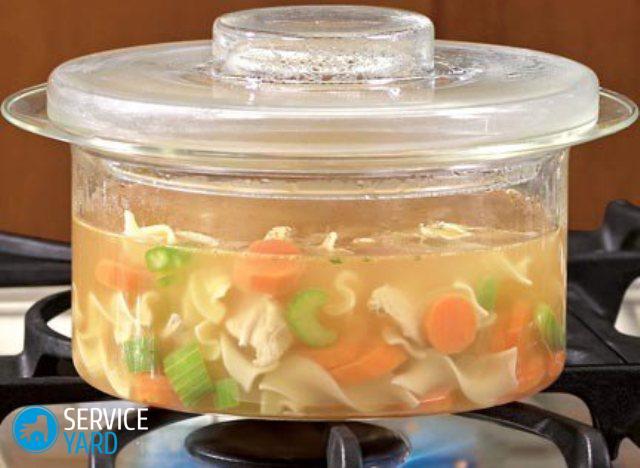
Disadvantages:
- Quite a high price compared to other types of pots.
- Heats up for a long time and cools down for a long time. Turn off the heating under it a few minutes before the dishes are ready.
- Very fragile. They can crack from shock or temperature changes.
- Do not put on open fire. Be sure to put a divider on the burner. When cooking, do not let the liquid boil away.
- Do not use abrasives or metal scrapers during cleaning. If you scratch the icing, the food will start to burn.
Important! You will not be mistaken with which company is better than a pot made of this material, if you choose products with a bottom thickness of 4-7 mm and similar walls when choosing.
Fireproof Glass Pans
This is also one of the novelties in the world of pots. In it you can cook soups, cereals, all kinds of side dishes, compotes and casseroles. But, like other types of pots, glass also has its pros and cons. Before running to the store for the latest kitchen invention, familiarize yourself with them.
Advantages:
- These pans are neutral to any food and do not emit any harmful substances in food. They are hygienic and environmentally friendly.
- They do not form scale, carbon deposits and other deposits.
- Glass pans are fairly easy to care for and clean.
- Suitable for all types of stoves, except induction. Glassware can also be used in the microwave and in the oven.
- They can be washed in the dishwasher.
- These pans look stylish in the kitchen and delight the eye when serving.
- They can store cooked dishes as much as desired.
Disadvantages:
- Refractory glass, like any other, can break from impact.
- It does not like sudden changes in temperature and can crack if, immediately after cooking, you put the pan under cold water. Also make sure that there is a sufficient level of fluid inside - if it boils off completely, this will also lead to damage.
- In a glass dish you cannot cook dishes containing eggs. They stick to the bottom, even with oil. Also, they do not recommend frying in them and stewing dishes for a long time.
- If you have a gas stove, then when using this utensil, you should always put a fire divider on the burner.
to contents ↑Important! When choosing, consider the quality of the glass itself - a turquoise or bluish color, the absence of sagging, cracks, scratches, will be an excellent sign. The lid should fit well against the walls and not slide off the vessel when tilted to 45 degrees. Give preference to European manufacturers - Tissona, Firex, Fissman.
Stock footage
After reviewing the useful information about the main characteristics of various types of kitchen utensils, each housewife will decide for herself which pan is best to choose. The main thing when buying, be careful and do not miss the defects, because not only the life of your pan, but also the health of your family depends on it.
- How to choose a vacuum cleaner taking into account the characteristics of the house and coatings?
- What to look for when choosing a water delivery
- How to quickly create comfort at home - tips for housewives
- How to choose the perfect TV - useful tips
- What to look for when choosing blinds
- What should be running shoes?
- What useful things can you buy in a hardware store
- Iphone 11 pro max review
- Than iPhone is better than Android smartphones



